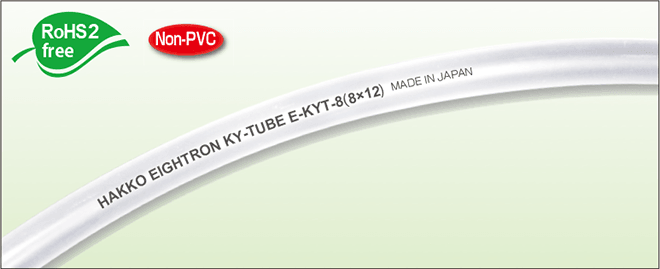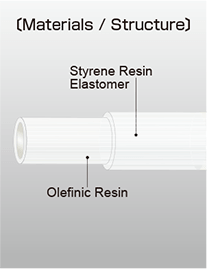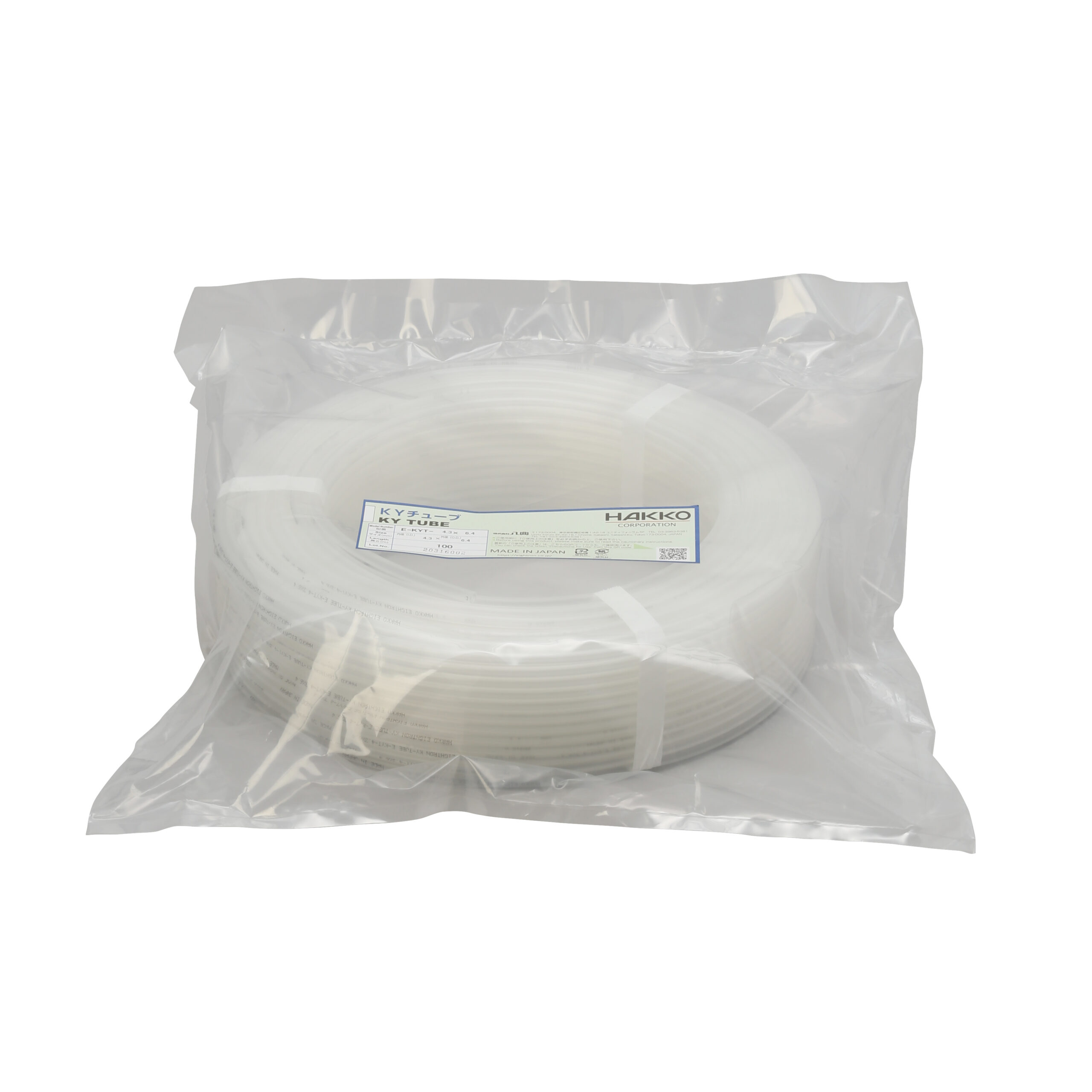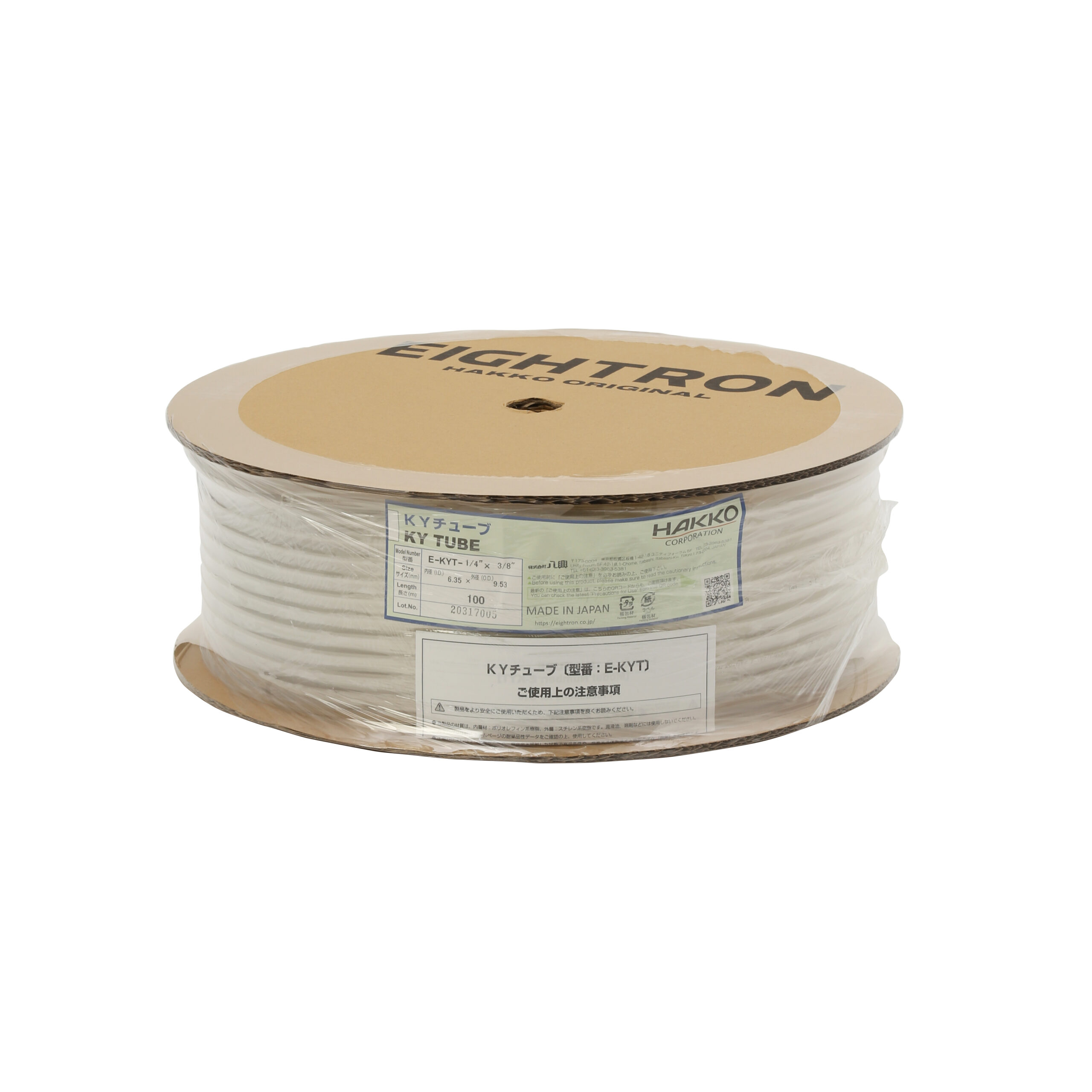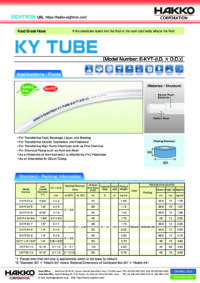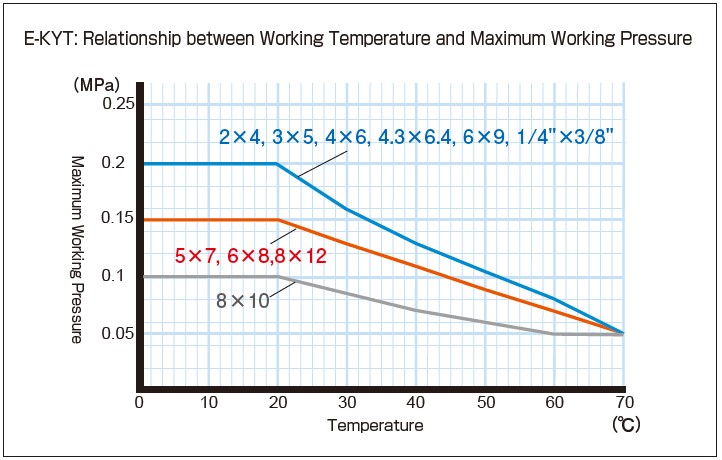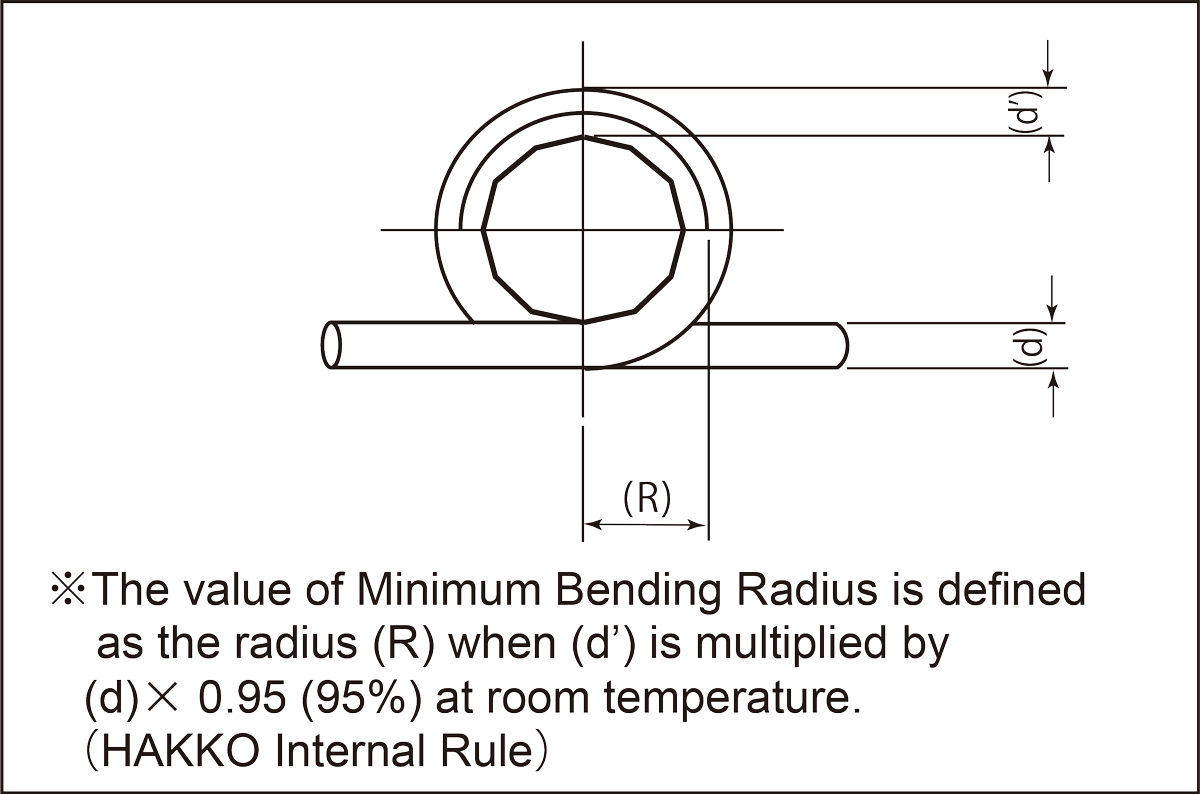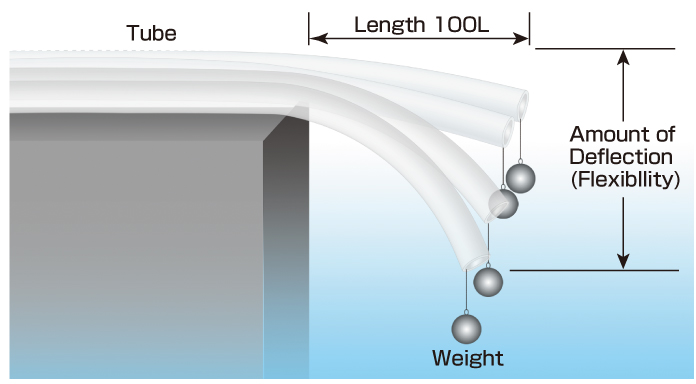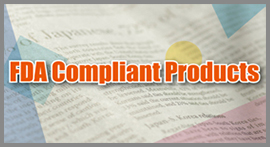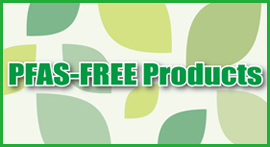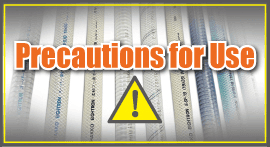KY TUBE [Model Number: E-KYT]
Food Grade and Industrial Tubing | Alcohol-Resistant Tubing | If the plasticizer soaks into the fluid or the resin odor badly affects the fluid
Fluids
 chemicals
chemicals ink
ink food
food drink
drink alcohol
alcohol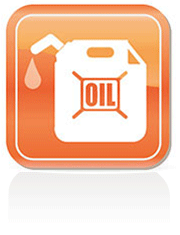 oil
oil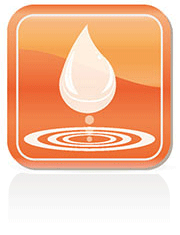 water
water powder
powder air
air Applications
- For Transferring Food, Beverage, Liquor and Brewing
- For Transferring Alcohol, Cosmetics and Fragrance
- For Transferring High Purity Chemicals such as Fine Chemical
- For Transferring Cooling Water for Supercomputer and Semiconductor Device
- For Chemical Piping such as Acid and Alkali
- For Transferring Coolant Liquid (Ethylene Glycol)
- For Transferring Sodium Hypochlorite as the Purpose of Sterilization and Disinfection
- For Transferring Waste Inks
- As a Protection of the Fluid which is affected by PVC Plasticizer
- As an Alternative for Silicon Tubing
Functions
Non-PVC
Chemical Resistance
Low Elution
Low Odor
Food-Sanitation
Flexibility
Alcohol Resistance
Characteristics
- Flexibility...Compared with other non-PVC tubing, E-KYT shows higher levels of flexibility. This greatly improves work efficiency.
- Non-PVC...E-KYT is an eco-friendly tubing, which is made of Olefin Resin and Styrene Resin Elastomer.
- Environment-Friendly...E-KYT restrains the production of harmful gas, even though it is burned out.
- Plasticizer-Free...E-KYT does not contain plasticizer (an elution material) at all. E-KYT is an oil-free tubing.
- Low Elution and Low Odor...Compared with PVC hose, elution levels are low. It is suitable for transferring food, beverage and cosmetics.
- Moderate Chemical Resistance...Since the inner layer is made of Olefin Resin, E-KYT shows moderate levels of chemical resistance.
- Easy to Cut...Since we print the cut mark on the hose every meter, it is easy to cut the length you would like to.
- Transparency...E-KYT (natural color) enables you to check the fluid very easily.
- Original Fittings...By using our original fittings, you can avoid accidents which are caused by incorrect choices of hose and fittings. For more information on our original fittings, please scroll down to the end.
Certificates and Regulations
- RoHS Compliant...E-KYT is compliant with RoHS requirements (Directive: (EU) 2015/863). (RoHS Compliant means that E-KYT does not contain RoHS 10 restricted substances or it does not exceed the upper threshold of RoHS 10 restricted substances.) Certificate is available on request.
- EU REACH and UK REACH...E-KYT is compliant with REACH SVHC 31st list (242 substances). Certificate is available on request.
- Non-Use of UV-328...E-KYT does not contain UV-328. Certificate is available on request.
- Non-Use of PFAS...E-KYT does not contain PFAS substances. Certificate is available on request.
- Food Sanitation Act Compliant...E-KYT conforms to the Food Sanitation Act No.380 (No.380 of the Ministry of Health and Welfare for Food Sanitation) (Conformity to N-Heptane) and the Food Sanitation Act No.324 (Positive List System) [No.324 of the Ministry of Health, Labour, and Welfare]. Regarding the conformity of the Food Sanitation Act No.324 (Positive List System), please download the certificate.
Packing Images
Product Standard
- Temperature Range : 0 - 70 $^\circ$C
- Color : Natural
*Please note that the value of "Minimum Bend Radius" is NOT equal to that of "Flexibility." About "Flexibility," please refer to the value of "Amount of Deflection" in the section of Technical Information or request the sample.
Leaflet Request
For more information on our Product Standard of E-KYT, please click "Product Leaflet Download" above.
Specification Request
For more technical information (such as Thickness of Each Layer and Precautions in Use) on E-KYT, please click "Product Specification Download" above.
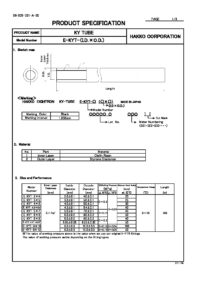
Cautions:
- We do not have our original fittings for E-KYT-4.3$\times$6.4, E-KYT-8$\times$10 and E-KYT-1/4"$\times$3/8".
- Due to the laminated structure tubing, please use the joints to seal an inner surface of the tubing. Please do not use the joints to seal an outer surface of the tubing. This may result in the bursting or coming off from the tubing.
- When you use our products, please refer to "Precautions for Use." ("The Precautions for Use" of E-KYT is also downloadable here.)
- In terms of chemical resistance, please refer to "Chemical Resistance Data."
- Although the inner layer is resistant to fluids, depending on working environments, the fluids would be permeated through the inner layer, resulting in the danger of swelling and degradation of the middle or outer layer.
Application Examples
Example 1: As a Piping for Sodium Hypochlorite
Company A is looking for a soft, economical tubing that can be used for transferring sodium hypochlorite in the process of disinfection of cut vegetables. A PVC tubing is not allowed to use due to the elution from the PVC tubing to the fluid. Company A finds HAKKO E-KYT and requests a sample. After their sample trial, the result is satisfactory. E-KYT is used as a piping for sterilization of raw vegetables.
Example 2: Tubing as Protective Cover
Company A is looking for something as protective cover for copper wire. Due to the limited budget, protective cover must be a reasonable price. An engineer at Company A found HAKKO E-KYT and requested the sample. E-KYT is soft and easy to use. Besides, E-KYT is made of non-PVC materials and compliant in RoHS 2 requirements. As a result, Company A made a decision that E-KYT can be used as protective cover for copper wire.
Frequently Asked Question
Question: We understand that an inner layer of E-KYT is made of Olefin. What kinds of chemical can be transferred through Olefin?
Answer: Although in terms of chemical resistance, Olefin is lower than Fluorine, some types of chemicals are transferrable. For instance, isopropyl alcohol, phenol, alkali, methanol, ethanol, and sodium hypochlorite are transferrable. (Please note that depending on the other using conditions, those chemicals might not be resistant against Olefin. Please check in advance.)
Technical Information
(A) Relationship Graph between Working Temperature and Maximum Working Pressure
(B) Amount of Deflection, Minimum Bend Radius and Kink Resistance Data
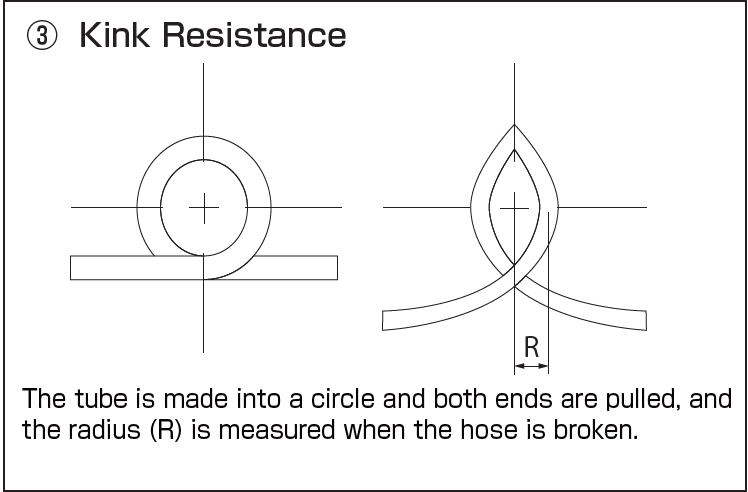
Results: "Amount of Deflection" is one indication of flexibility. Flexibility varies depending on hose (tubing). The larger the amount of deflection is, the more flexible the hose (tubing) is. Thus, E-KYT is much more flexible than E-PD and E-SJ tubing.
(C) Combustion Gas Data on Raw Material of KY TUBE
*Test Method: JIS K7217
(D) Leach Test Data
Notes: Depending on the materials of the hose, plasticizer and stabilizer may elute. Data on the above show the levels of low elution of E-KYT. The results above are measured values are NOT guaranteed.
*Test Method: JIS S 3200-7: 2004 [Equipment for Water Supply Service]
*Hose Cleaning-Up
If you wash the hose in hot water, hot water must be lower than 80 $^\circ$C (176 $^\circ$F), less than 30 minutes and less than 0.1 MPa (1kgf/cm2) (One-Side Free Condition).
HAKKO Original Fittings for E-KYT
| Product Name | Materials, Characteristics |
| Fittings for Multi-Layer Tubing [Model Number: E-FTS-F]] |
- Material: SUS316L (SS316L) (Body) and SUS304 (SS304) (Nut)
- It is designed by HAKKO tubing products, so you do not have to worry about fluid leakages and coming off.
- Specify temperature range and working pressure for each product.
- It is excellent in corrosion resistance [Body: SUS316L (SS316L)].
- Since it is made of stainless steel (Passivation Treatment), you can transfer a wide variety of fluids.
|
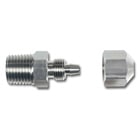
|
| PEEK (Carbon Reinforced) Nut Type Fittings [Model Number: AL]] |
- Material: PEEK
- Lightweight...Fitting weight is less than one-fifth, compared to same-size SUS joints, leading to overall weight reduction of equipment.
- Great Heat Resistance...PEEK material has excellent heat resistance among resins.
- Chemical Resistance...PEEK material has excellent resistance to a wide range of chemicals including acids, alkalis and organic solvents.
- Mechanical Strength...Carbon fiber is added to the engineering plastic of PEEK, which is strong in tensile and impact resistance.
|
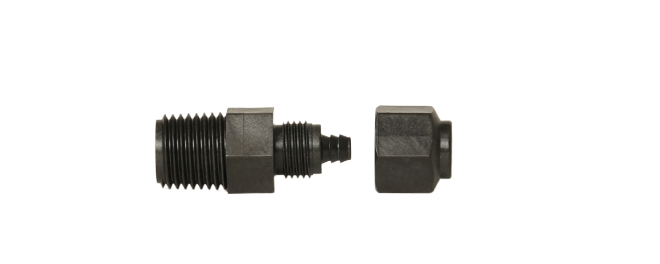
|
| Fittings for Multi-Layer Tubing (with Tubing Guide) [Model Number: E-FTS-GN]] |
- Material: SUS316L (SS316L) (Body) and SUS304 (SS304) (Nut)
- It is designed by HAKKO tubing products, so you do not have to worry about fluid leakages and coming off.
- Specify temperature range and working pressure for each product.
- It is excellent in corrosion resistance [Body: SUS316L (SS316L)].
- Since it is made of stainless steel (Passivation Treatment), you can transfer a wide variety of fluids.
|
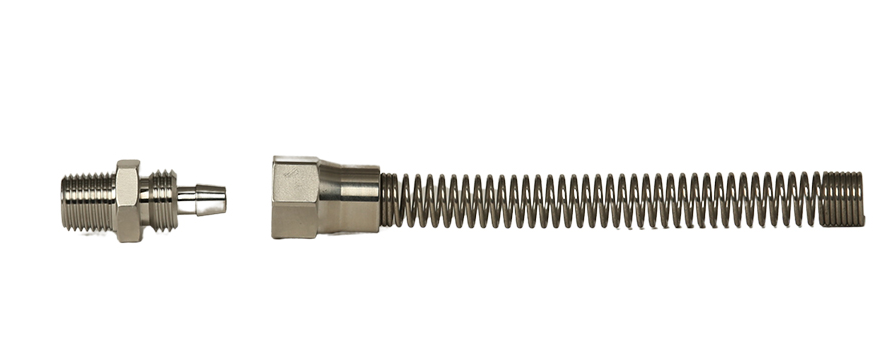
|

